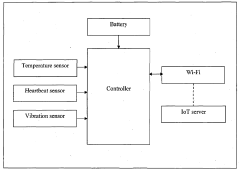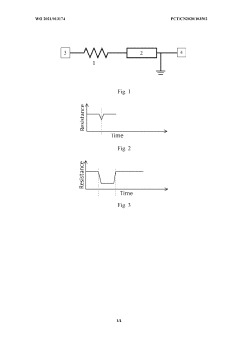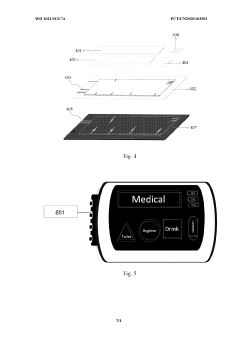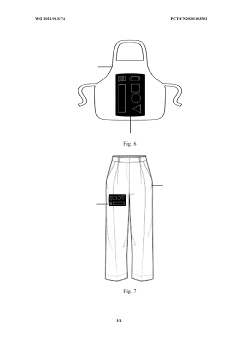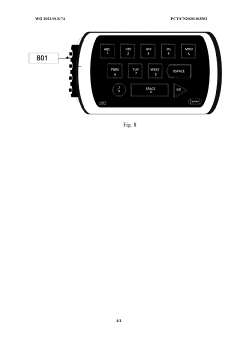Graphene In Wearable Technology: Next-Gen Health Monitoring
MAY 13, 20259 MIN READ
Generate Your Research Report Instantly with AI Agent
Patsnap Eureka helps you evaluate technical feasibility & market potential.
Graphene Wearables: Evolution and Objectives
Graphene, a two-dimensional carbon allotrope, has emerged as a revolutionary material in the field of wearable technology, particularly in health monitoring applications. Since its isolation in 2004, graphene has captivated researchers and industry professionals alike due to its exceptional properties, including high electrical conductivity, flexibility, and strength. The evolution of graphene in wearable technology has been marked by significant milestones, from initial laboratory experiments to the development of prototype devices and, more recently, commercially viable products.
The journey of graphene in wearable health monitoring began with the exploration of its unique characteristics, such as its ability to form ultrathin, flexible, and highly conductive films. Early research focused on leveraging these properties to create sensors capable of detecting various physiological parameters with unprecedented sensitivity and accuracy. As the field progressed, scientists and engineers worked to overcome challenges related to large-scale production, integration with other materials, and biocompatibility.
The objectives of incorporating graphene into wearable health monitoring devices are multifaceted and ambitious. Primarily, researchers aim to develop sensors that can provide continuous, real-time monitoring of vital signs and biomarkers with minimal invasiveness and maximum comfort for users. This includes the creation of flexible, skin-conforming patches that can measure parameters such as heart rate, blood pressure, glucose levels, and even complex biomarkers indicative of various health conditions.
Another key objective is to enhance the power efficiency and longevity of wearable devices. Graphene's excellent electrical properties offer the potential for energy-harvesting systems that could extend battery life or even enable self-powered devices. Additionally, the material's thermal conductivity properties are being explored to address heat dissipation issues in wearable electronics.
Looking ahead, the ultimate goal is to develop a new generation of wearable health monitoring devices that seamlessly integrate with the human body, providing comprehensive health data with unparalleled accuracy and reliability. This includes the development of graphene-based neural interfaces for advanced prosthetics and brain-computer interfaces, as well as smart textiles that can monitor a wide range of physiological parameters while maintaining the look and feel of ordinary clothing.
As research continues to advance, the focus is increasingly shifting towards addressing practical challenges such as scalability, cost-effectiveness, and regulatory compliance. The successful realization of these objectives promises to revolutionize personal healthcare, enabling proactive health management, early disease detection, and personalized treatment strategies. The evolution of graphene in wearable technology for health monitoring represents a convergence of materials science, electronics, and healthcare, poised to transform the way we monitor and manage our health in the coming decades.
The journey of graphene in wearable health monitoring began with the exploration of its unique characteristics, such as its ability to form ultrathin, flexible, and highly conductive films. Early research focused on leveraging these properties to create sensors capable of detecting various physiological parameters with unprecedented sensitivity and accuracy. As the field progressed, scientists and engineers worked to overcome challenges related to large-scale production, integration with other materials, and biocompatibility.
The objectives of incorporating graphene into wearable health monitoring devices are multifaceted and ambitious. Primarily, researchers aim to develop sensors that can provide continuous, real-time monitoring of vital signs and biomarkers with minimal invasiveness and maximum comfort for users. This includes the creation of flexible, skin-conforming patches that can measure parameters such as heart rate, blood pressure, glucose levels, and even complex biomarkers indicative of various health conditions.
Another key objective is to enhance the power efficiency and longevity of wearable devices. Graphene's excellent electrical properties offer the potential for energy-harvesting systems that could extend battery life or even enable self-powered devices. Additionally, the material's thermal conductivity properties are being explored to address heat dissipation issues in wearable electronics.
Looking ahead, the ultimate goal is to develop a new generation of wearable health monitoring devices that seamlessly integrate with the human body, providing comprehensive health data with unparalleled accuracy and reliability. This includes the development of graphene-based neural interfaces for advanced prosthetics and brain-computer interfaces, as well as smart textiles that can monitor a wide range of physiological parameters while maintaining the look and feel of ordinary clothing.
As research continues to advance, the focus is increasingly shifting towards addressing practical challenges such as scalability, cost-effectiveness, and regulatory compliance. The successful realization of these objectives promises to revolutionize personal healthcare, enabling proactive health management, early disease detection, and personalized treatment strategies. The evolution of graphene in wearable technology for health monitoring represents a convergence of materials science, electronics, and healthcare, poised to transform the way we monitor and manage our health in the coming decades.
Market Demand for Advanced Health Monitoring
The wearable technology market has witnessed significant growth in recent years, with a particular emphasis on health monitoring devices. As consumers become increasingly health-conscious and proactive about managing their well-being, the demand for advanced health monitoring solutions has surged. This trend is further accelerated by the global pandemic, which has heightened awareness of personal health and the importance of early detection of health issues.
The market for advanced health monitoring wearables is expected to experience robust growth in the coming years. According to recent market research, the global wearable healthcare devices market is projected to reach $46.6 billion by 2025, growing at a CAGR of 28.1% from 2020 to 2025. This growth is driven by factors such as the increasing prevalence of chronic diseases, rising healthcare costs, and the growing elderly population.
Consumers are seeking more sophisticated health monitoring capabilities that go beyond basic fitness tracking. There is a growing demand for wearables that can provide continuous, real-time monitoring of vital signs, including heart rate, blood pressure, blood oxygen levels, and even early detection of potential health issues. The ability to track and analyze health data over time is becoming increasingly valuable to both consumers and healthcare providers.
The healthcare industry is also showing significant interest in advanced health monitoring wearables. These devices have the potential to revolutionize patient care by enabling remote monitoring, reducing hospital readmissions, and facilitating early intervention. Healthcare providers are increasingly looking to integrate wearable technology into their patient care strategies to improve outcomes and reduce costs.
Moreover, there is a growing market for specialized health monitoring wearables targeting specific medical conditions. For instance, there is increasing demand for devices that can monitor glucose levels for diabetics, track cardiac health for heart patients, or monitor sleep patterns for those with sleep disorders. This trend towards personalized health monitoring is expected to drive innovation and create new market opportunities.
The integration of artificial intelligence and machine learning capabilities in health monitoring wearables is another area of significant market demand. Consumers and healthcare professionals alike are seeking devices that can not only collect data but also provide meaningful insights and predictive analytics.
As the market for advanced health monitoring wearables continues to evolve, there is a clear demand for technologies that can enhance the accuracy, reliability, and functionality of these devices. This is where graphene, with its unique properties, has the potential to play a transformative role in the next generation of wearable health monitoring technology.
The market for advanced health monitoring wearables is expected to experience robust growth in the coming years. According to recent market research, the global wearable healthcare devices market is projected to reach $46.6 billion by 2025, growing at a CAGR of 28.1% from 2020 to 2025. This growth is driven by factors such as the increasing prevalence of chronic diseases, rising healthcare costs, and the growing elderly population.
Consumers are seeking more sophisticated health monitoring capabilities that go beyond basic fitness tracking. There is a growing demand for wearables that can provide continuous, real-time monitoring of vital signs, including heart rate, blood pressure, blood oxygen levels, and even early detection of potential health issues. The ability to track and analyze health data over time is becoming increasingly valuable to both consumers and healthcare providers.
The healthcare industry is also showing significant interest in advanced health monitoring wearables. These devices have the potential to revolutionize patient care by enabling remote monitoring, reducing hospital readmissions, and facilitating early intervention. Healthcare providers are increasingly looking to integrate wearable technology into their patient care strategies to improve outcomes and reduce costs.
Moreover, there is a growing market for specialized health monitoring wearables targeting specific medical conditions. For instance, there is increasing demand for devices that can monitor glucose levels for diabetics, track cardiac health for heart patients, or monitor sleep patterns for those with sleep disorders. This trend towards personalized health monitoring is expected to drive innovation and create new market opportunities.
The integration of artificial intelligence and machine learning capabilities in health monitoring wearables is another area of significant market demand. Consumers and healthcare professionals alike are seeking devices that can not only collect data but also provide meaningful insights and predictive analytics.
As the market for advanced health monitoring wearables continues to evolve, there is a clear demand for technologies that can enhance the accuracy, reliability, and functionality of these devices. This is where graphene, with its unique properties, has the potential to play a transformative role in the next generation of wearable health monitoring technology.
Current Graphene Integration Challenges
Despite the promising potential of graphene in wearable technology for health monitoring, several significant challenges currently hinder its widespread integration. One of the primary obstacles is the scalable production of high-quality graphene. While laboratory-scale production has shown remarkable results, translating this to industrial-scale manufacturing while maintaining consistent quality and properties remains a significant hurdle. The current methods, such as chemical vapor deposition (CVD) and liquid-phase exfoliation, often struggle to produce large quantities of defect-free graphene sheets suitable for wearable applications.
Another critical challenge lies in the integration of graphene with existing electronic components and flexible substrates. Graphene's two-dimensional nature makes it difficult to interface with three-dimensional electronic systems without compromising its unique properties. Additionally, ensuring stable electrical connections between graphene and other materials in a flexible, wearable format presents considerable engineering challenges. The development of reliable and durable graphene-based sensors that can withstand the mechanical stresses of daily wear and tear is also an ongoing area of research.
Biocompatibility and long-term stability of graphene in contact with human skin pose further challenges. While initial studies have shown promising results regarding graphene's biocompatibility, more comprehensive long-term studies are needed to ensure its safety for continuous skin contact in wearable devices. Moreover, the potential degradation of graphene under various environmental conditions, such as sweat, UV exposure, and temperature fluctuations, needs to be thoroughly investigated and addressed.
The development of graphene-based flexible energy storage solutions, crucial for powering wearable devices, is another area facing significant challenges. While graphene shows promise in enhancing the performance of batteries and supercapacitors, integrating these power sources into thin, flexible, and comfortable wearable formats without compromising their efficiency or safety remains a complex task.
Lastly, the cost of graphene production and integration into wearable devices is still prohibitively high for mass-market adoption. Developing cost-effective manufacturing processes that can produce high-quality graphene at scale, while also being environmentally sustainable, is crucial for the commercial viability of graphene-based wearable health monitoring devices.
Overcoming these challenges requires interdisciplinary collaboration between materials scientists, electrical engineers, biomedical researchers, and manufacturing experts. As research progresses, innovative solutions to these integration challenges will likely emerge, paving the way for the next generation of graphene-enhanced wearable health monitoring technologies.
Another critical challenge lies in the integration of graphene with existing electronic components and flexible substrates. Graphene's two-dimensional nature makes it difficult to interface with three-dimensional electronic systems without compromising its unique properties. Additionally, ensuring stable electrical connections between graphene and other materials in a flexible, wearable format presents considerable engineering challenges. The development of reliable and durable graphene-based sensors that can withstand the mechanical stresses of daily wear and tear is also an ongoing area of research.
Biocompatibility and long-term stability of graphene in contact with human skin pose further challenges. While initial studies have shown promising results regarding graphene's biocompatibility, more comprehensive long-term studies are needed to ensure its safety for continuous skin contact in wearable devices. Moreover, the potential degradation of graphene under various environmental conditions, such as sweat, UV exposure, and temperature fluctuations, needs to be thoroughly investigated and addressed.
The development of graphene-based flexible energy storage solutions, crucial for powering wearable devices, is another area facing significant challenges. While graphene shows promise in enhancing the performance of batteries and supercapacitors, integrating these power sources into thin, flexible, and comfortable wearable formats without compromising their efficiency or safety remains a complex task.
Lastly, the cost of graphene production and integration into wearable devices is still prohibitively high for mass-market adoption. Developing cost-effective manufacturing processes that can produce high-quality graphene at scale, while also being environmentally sustainable, is crucial for the commercial viability of graphene-based wearable health monitoring devices.
Overcoming these challenges requires interdisciplinary collaboration between materials scientists, electrical engineers, biomedical researchers, and manufacturing experts. As research progresses, innovative solutions to these integration challenges will likely emerge, paving the way for the next generation of graphene-enhanced wearable health monitoring technologies.
Existing Graphene-Based Health Monitoring Solutions
01 Graphene-based wearable health monitoring devices
Wearable devices incorporating graphene sensors for continuous health monitoring. These devices can track various physiological parameters such as heart rate, blood pressure, and body temperature. The flexibility and conductivity of graphene allow for comfortable, long-term wear and accurate data collection.- Graphene-based wearable health monitoring devices: Wearable devices incorporating graphene sensors for continuous health monitoring. These devices can track various physiological parameters such as heart rate, blood pressure, and body temperature. The flexibility and conductivity of graphene allow for comfortable, non-invasive monitoring with high sensitivity and accuracy.
- Graphene biosensors for disease detection: Development of graphene-based biosensors for early detection and monitoring of various diseases. These sensors can detect specific biomarkers in bodily fluids with high sensitivity, enabling rapid and accurate diagnosis. The unique properties of graphene allow for miniaturization and integration into portable diagnostic devices.
- Graphene-enhanced medical imaging: Utilization of graphene in medical imaging technologies to improve resolution and sensitivity. Graphene-based contrast agents and sensors can enhance various imaging modalities such as MRI, CT, and ultrasound, leading to more accurate diagnoses and treatment monitoring.
- Graphene-based drug delivery systems: Development of graphene-based nanocarriers for targeted drug delivery and real-time monitoring of drug efficacy. These systems can improve drug bioavailability, reduce side effects, and provide feedback on treatment effectiveness through integrated sensors.
- Graphene in neural interfaces and brain monitoring: Application of graphene in neural interfaces and brain monitoring devices. Graphene's excellent electrical conductivity and biocompatibility make it ideal for creating high-resolution neural electrodes and sensors for monitoring brain activity and treating neurological disorders.
02 Graphene biosensors for disease detection
Development of highly sensitive graphene-based biosensors for early detection of diseases. These sensors can detect specific biomarkers in bodily fluids, enabling rapid and accurate diagnosis of various health conditions. The high surface area and electrical properties of graphene enhance the sensitivity and specificity of these biosensors.Expand Specific Solutions03 Graphene-enhanced medical imaging
Integration of graphene into medical imaging technologies to improve resolution and sensitivity. Graphene's unique properties can enhance various imaging modalities such as MRI, CT, and ultrasound, leading to more accurate diagnoses and treatment planning.Expand Specific Solutions04 Graphene-based drug delivery systems
Utilization of graphene and its derivatives for targeted drug delivery. The large surface area and functionalization capabilities of graphene allow for efficient drug loading and controlled release, potentially improving treatment efficacy and reducing side effects in various medical applications.Expand Specific Solutions05 Graphene in neural interfaces and brain-computer interfaces
Application of graphene in developing advanced neural interfaces and brain-computer interfaces. The material's excellent electrical conductivity and biocompatibility make it suitable for creating high-resolution neural electrodes and sensors, potentially revolutionizing treatments for neurological disorders and enhancing human-machine interactions.Expand Specific Solutions
Key Players in Graphene Wearable Industry
The graphene-based wearable technology for health monitoring is in its early growth stage, with a rapidly expanding market driven by increasing demand for personalized healthcare solutions. The global market for this technology is projected to grow significantly in the coming years, fueled by advancements in material science and miniaturization. Companies like IBM, Philips, and Google are leading the charge, leveraging their expertise in electronics and data analytics to develop cutting-edge solutions. Emerging players such as Nanowear and Bloomer Health Tech are also making significant strides, focusing on specialized applications. The technology's maturity varies across different applications, with some areas like ECG monitoring being more advanced, while others like continuous glucose monitoring are still in development stages.
Koninklijke Philips NV
Technical Solution: Philips has been incorporating graphene-based sensors into their wearable health monitoring devices. Their approach focuses on developing flexible, skin-adherent patches that use graphene's properties to measure various physiological parameters. These patches can monitor heart rate, respiratory rate, and skin temperature continuously. Philips is also exploring the use of graphene in their remote patient monitoring systems, aiming to improve the accuracy and reliability of data collection for chronic disease management and post-operative care.
Strengths: Strong presence in the healthcare industry; Extensive experience in medical-grade device development and regulatory compliance. Weaknesses: May face challenges in balancing cost-effectiveness with advanced technology implementation; Potential limitations in consumer market penetration compared to tech-focused companies.
International Business Machines Corp.
Technical Solution: IBM has been researching the application of graphene in wearable health monitoring technology through its nanotechnology and IoT divisions. They have developed graphene-based sensors that can be integrated into flexible, wearable devices for continuous health monitoring. IBM's approach focuses on creating ultra-thin, highly sensitive sensors that can detect various biomarkers in sweat or other bodily fluids. They are also exploring the use of AI and machine learning algorithms to analyze the data collected by these graphene-based sensors, aiming to provide more accurate and personalized health insights.
Strengths: Strong capabilities in data analytics and AI integration; Extensive research and development resources; Potential for cross-industry collaborations. Weaknesses: Less experience in consumer wearable product development; May face challenges in translating research into commercially viable products.
Breakthrough Graphene Sensor Innovations
Deep learning based wearable health monitoring system
PatentPendingIN202121059570A
Innovation
- A deep learning-based IoT-enabled real-time health monitoring system utilizing wearable devices with sensors like temperature, heartbeat, vibration, and Wi-Fi modules, which processes data using various deep learning algorithms to extract features and provide immediate analysis and monitoring of physiological signs.
Pressure sensor, preparation method and application thereof and wearable smart fabric comprising the same
PatentWO2021013174A1
Innovation
- Development of a truly wearable smart fabric with integrated pressure sensing capabilities.
- Utilization of graphene's unique properties (thermal, mechanical, electrical) in a fabric-based pressure sensor design.
- Creation of a pressure sensor that maintains comfort and flexibility while integrated into fabric.
Biocompatibility and Safety Considerations
As wearable technology continues to advance, the integration of graphene into health monitoring devices presents both exciting opportunities and significant challenges in terms of biocompatibility and safety. Graphene's unique properties, including its exceptional electrical conductivity, flexibility, and strength, make it an attractive material for next-generation wearable sensors. However, its potential interactions with biological systems must be carefully evaluated to ensure user safety and regulatory compliance.
One of the primary concerns regarding graphene in wearable technology is its potential toxicity. While bulk graphene is generally considered inert, nanoparticles and graphene oxide may pose risks if they enter the body through skin contact or inhalation. Studies have shown that graphene's toxicity can vary depending on factors such as particle size, surface functionalization, and exposure duration. Therefore, comprehensive toxicological assessments are essential to determine safe exposure levels and potential long-term effects.
Another critical aspect of biocompatibility is the potential for graphene-based materials to cause skin irritation or allergic reactions. Wearable devices are in prolonged contact with the skin, making it crucial to ensure that graphene-containing components do not cause adverse dermal effects. This requires extensive testing of various graphene formulations and surface treatments to identify those that are both functionally effective and skin-friendly.
The stability of graphene in physiological conditions is also a key consideration. Researchers must investigate how graphene behaves when exposed to sweat, skin oils, and other bodily fluids to ensure that it maintains its structural integrity and does not degrade into potentially harmful byproducts. This includes evaluating the potential for graphene to leach from devices and assessing any associated risks.
From a regulatory standpoint, the use of graphene in wearable health monitoring devices necessitates rigorous safety evaluations to meet standards set by organizations such as the FDA and EMA. Manufacturers must demonstrate that their graphene-based products are safe for their intended use, which may involve extensive in vitro and in vivo testing, as well as clinical trials for certain applications.
To address these biocompatibility and safety challenges, researchers are exploring various strategies. These include developing biocompatible coatings for graphene-based sensors, optimizing graphene synthesis methods to reduce potential contaminants, and investigating hybrid materials that combine graphene with other biocompatible substances. Additionally, advancements in encapsulation techniques are being pursued to prevent direct contact between graphene and the skin while maintaining the material's sensing capabilities.
As the field progresses, establishing standardized protocols for assessing the biocompatibility and safety of graphene in wearable technology will be crucial. This will require collaboration between materials scientists, toxicologists, and regulatory experts to develop comprehensive guidelines that ensure the safe and effective integration of graphene into next-generation health monitoring devices.
One of the primary concerns regarding graphene in wearable technology is its potential toxicity. While bulk graphene is generally considered inert, nanoparticles and graphene oxide may pose risks if they enter the body through skin contact or inhalation. Studies have shown that graphene's toxicity can vary depending on factors such as particle size, surface functionalization, and exposure duration. Therefore, comprehensive toxicological assessments are essential to determine safe exposure levels and potential long-term effects.
Another critical aspect of biocompatibility is the potential for graphene-based materials to cause skin irritation or allergic reactions. Wearable devices are in prolonged contact with the skin, making it crucial to ensure that graphene-containing components do not cause adverse dermal effects. This requires extensive testing of various graphene formulations and surface treatments to identify those that are both functionally effective and skin-friendly.
The stability of graphene in physiological conditions is also a key consideration. Researchers must investigate how graphene behaves when exposed to sweat, skin oils, and other bodily fluids to ensure that it maintains its structural integrity and does not degrade into potentially harmful byproducts. This includes evaluating the potential for graphene to leach from devices and assessing any associated risks.
From a regulatory standpoint, the use of graphene in wearable health monitoring devices necessitates rigorous safety evaluations to meet standards set by organizations such as the FDA and EMA. Manufacturers must demonstrate that their graphene-based products are safe for their intended use, which may involve extensive in vitro and in vivo testing, as well as clinical trials for certain applications.
To address these biocompatibility and safety challenges, researchers are exploring various strategies. These include developing biocompatible coatings for graphene-based sensors, optimizing graphene synthesis methods to reduce potential contaminants, and investigating hybrid materials that combine graphene with other biocompatible substances. Additionally, advancements in encapsulation techniques are being pursued to prevent direct contact between graphene and the skin while maintaining the material's sensing capabilities.
As the field progresses, establishing standardized protocols for assessing the biocompatibility and safety of graphene in wearable technology will be crucial. This will require collaboration between materials scientists, toxicologists, and regulatory experts to develop comprehensive guidelines that ensure the safe and effective integration of graphene into next-generation health monitoring devices.
Regulatory Framework for Graphene Wearables
The regulatory framework for graphene wearables is a complex and evolving landscape that requires careful consideration as this innovative technology advances. As graphene-based wearable devices for health monitoring gain traction, regulatory bodies worldwide are grappling with the need to ensure safety, efficacy, and ethical use while fostering innovation. Currently, there is no specific regulatory framework exclusively for graphene wearables, and these devices often fall under existing regulations for medical devices, consumer electronics, and nanomaterials.
In the United States, the Food and Drug Administration (FDA) plays a crucial role in regulating wearable health technologies. Graphene wearables that make medical claims or are intended for diagnosis, treatment, or prevention of diseases would likely be classified as medical devices and subject to FDA oversight. The level of regulation depends on the device's risk classification, with higher-risk devices requiring more stringent controls and clinical evidence. The FDA has also issued guidance on the use of nanotechnology in FDA-regulated products, which may apply to graphene-based wearables.
In the European Union, the Medical Device Regulation (MDR) and the General Data Protection Regulation (GDPR) are key regulatory frameworks that impact graphene wearables. The MDR sets standards for safety and performance of medical devices, while the GDPR addresses data privacy concerns, which are particularly relevant for health monitoring wearables that collect and process personal health data.
Internationally, the International Organization for Standardization (ISO) has developed standards for nanotechnologies (ISO/TC 229) that may be applicable to graphene wearables. These standards address terminology, measurement, characterization, and health, safety, and environmental aspects of nanotechnologies.
As the field progresses, regulatory bodies are likely to develop more specific guidelines for graphene-based wearables. Key areas of focus include biocompatibility, long-term safety of graphene exposure, electromagnetic compatibility, data security, and accuracy of health measurements. Manufacturers and developers of graphene wearables must navigate this complex regulatory landscape, ensuring compliance with existing regulations while anticipating future developments.
Collaboration between industry, academia, and regulatory bodies will be crucial in shaping an appropriate regulatory framework that balances innovation with safety and ethical considerations. As graphene wearables continue to advance, it is expected that regulatory approaches will evolve to address the unique challenges and opportunities presented by this emerging technology in the field of health monitoring.
In the United States, the Food and Drug Administration (FDA) plays a crucial role in regulating wearable health technologies. Graphene wearables that make medical claims or are intended for diagnosis, treatment, or prevention of diseases would likely be classified as medical devices and subject to FDA oversight. The level of regulation depends on the device's risk classification, with higher-risk devices requiring more stringent controls and clinical evidence. The FDA has also issued guidance on the use of nanotechnology in FDA-regulated products, which may apply to graphene-based wearables.
In the European Union, the Medical Device Regulation (MDR) and the General Data Protection Regulation (GDPR) are key regulatory frameworks that impact graphene wearables. The MDR sets standards for safety and performance of medical devices, while the GDPR addresses data privacy concerns, which are particularly relevant for health monitoring wearables that collect and process personal health data.
Internationally, the International Organization for Standardization (ISO) has developed standards for nanotechnologies (ISO/TC 229) that may be applicable to graphene wearables. These standards address terminology, measurement, characterization, and health, safety, and environmental aspects of nanotechnologies.
As the field progresses, regulatory bodies are likely to develop more specific guidelines for graphene-based wearables. Key areas of focus include biocompatibility, long-term safety of graphene exposure, electromagnetic compatibility, data security, and accuracy of health measurements. Manufacturers and developers of graphene wearables must navigate this complex regulatory landscape, ensuring compliance with existing regulations while anticipating future developments.
Collaboration between industry, academia, and regulatory bodies will be crucial in shaping an appropriate regulatory framework that balances innovation with safety and ethical considerations. As graphene wearables continue to advance, it is expected that regulatory approaches will evolve to address the unique challenges and opportunities presented by this emerging technology in the field of health monitoring.
Unlock deeper insights with Patsnap Eureka Quick Research — get a full tech report to explore trends and direct your research. Try now!
Generate Your Research Report Instantly with AI Agent
Supercharge your innovation with Patsnap Eureka AI Agent Platform!
